Beekeeping, also known as apiculture, is the practice of keeping bees for the purpose of harvesting honey and other bee products. In South Africa, beekeeping has a long history and plays an important role in the environment and economy. Beekeeping is not only a rewarding venture for individuals, but it also offers numerous benefits to the environment and economy of South Africa. South Africa’s diverse climate and abundant flora make it an ideal location for beekeeping. Moreover, honey production provides income opportunities for many communities across the country.
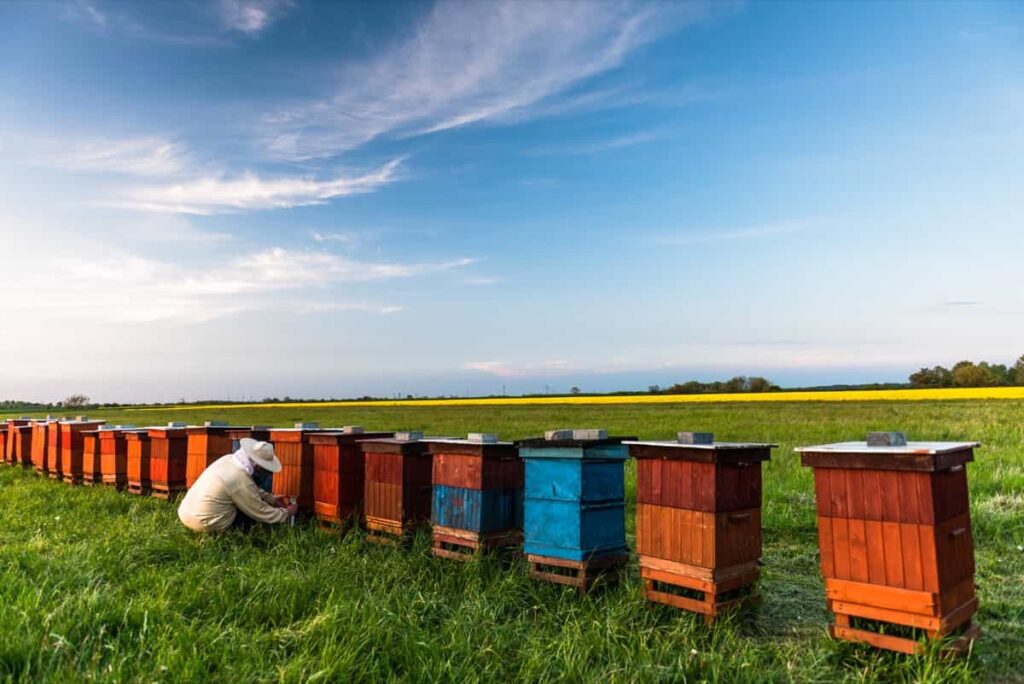
Choosing the Right Location for Your Beehives in South Africa
Bees are highly sensitive to their environment, and the location of their hives can greatly impact their productivity and overall health. When selecting a site for your beehives, it’s important to consider several factors. Firstly, bees thrive in areas with abundant sources of nectar and pollen. Look for locations with diverse plant life and flowering trees that can provide a continuous food supply for your bees throughout the year.
Additionally, it’s essential to choose a spot that offers protection from extreme weather conditions such as strong winds or excessive heat. Beehives should ideally be placed in an area with partial shade to prevent overheating during hot summer days. Another consideration is proximity to water sources. Bees require access to clean water for drinking and cooling down their hives. Ensure a reliable source is nearby, such as a pond or stream, so they don’t have to travel long distances.
Take into account any potential hazards or disturbances near the chosen location. Avoid placing hives near roads with heavy traffic or areas prone to chemical pesticide usage, as these can negatively affect bee populations. By selecting the right location for your beehives in South Africa, you’ll create an optimal environment where your bees can thrive and produce high-quality honey while contributing positively to local ecosystems through pollination activities.
Selecting the Ideal Bee Species for Beekeeping in South Africa
Selecting the ideal bee species for beekeeping in South Africa is a crucial decision that can greatly impact the success of your apiary. There are two main bee species in South Africa to consider: apis mellifera scutellata and apis mellifera capensis.
The first species, apis mellifera scutellata, is widely distributed throughout South Africa except for the Cape areas. It is known for its adaptability and resilience, making it well-suited to various climatic conditions nationwide. These bees are known for their high productivity and ability to withstand harsh environments.
On the other hand, the other species of apis mellifera capensis is also called the Cape bee. Originally to the Western and Eastern Cape areas of South Africa, this species has unique characteristics that make it desirable for certain beekeepers. They are particularly well-adapted to fynbos vegetation found in these regions.
Understanding the Legal Requirements for Beekeeping in South Africa
Beekeepers need to register with their local Provincial Veterinary Services office. This registration is necessary because bees are considered livestock and fall under veterinary legislation. It’s important to note that each province may have slightly different regulations, so check with your specific provincial office for accurate information. Additionally, beekeepers must comply with certain biosecurity measures to prevent the spread of diseases among bees.
In case you missed it: Catfish Farming in South Africa: Business Plan, Cost and Profit Analysis
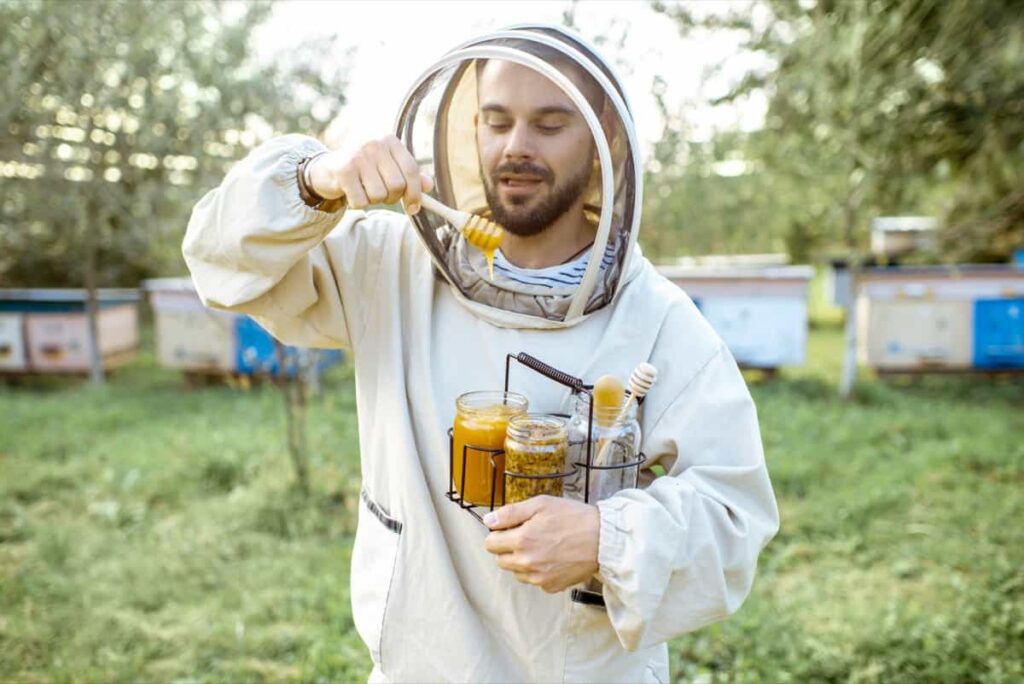
Regular inspections by officials may also be required as part of these measures. Furthermore, suppose you plan on selling honey or other bee products commercially. In that case, you must obtain permits from relevant authorities such as the Department of Agriculture or Food Control Agencies. These permits ensure your products meet health and safety standards before entering the market.
Obtaining a Beekeeping License in South Africa: Step-by-Step Process
Research and Preparation – Start by thoroughly researching the legal requirements for beekeeping in South Africa. Familiarize yourself with the regulations set by the DALRRD (Department of Agriculture, Land Reform, and Rural Development). This will give you a clear understanding of what is expected from you as a beekeeper.
Attend Training and Workshops – To ensure you have all the necessary knowledge and skills to succeed, consider attending training programs or workshops from reputable beekeeping associations or organizations. These educational opportunities will provide practical insights into hive management techniques, disease prevention strategies, and honey harvesting methods.
Application Submission – Once you feel confident in your understanding of beekeeping practices, it’s time to apply for your license. Contact your local DALRRD office or agricultural department for specific guidelines on proceeding with this step. Be prepared to provide information about your apiary location, equipment used, pest management protocols, and other relevant details.
Inspection – After submitting your application, expect a visit from an inspector appointed by DALRRD. They will assess whether your apiary meets the required standards regarding safety measures and biosecurity protocols. This inspection is crucial as it ensures that both native bees and surrounding environments are protected.
License Approval – You’ll receive approval for your beekeeping license from DALRRD. Remember that maintaining compliance with regulations is essential throughout your journey as a licensed beekeeper.
The Cost of Starting Beekeeping in South Africa: Budgeting and Expenses
Starting beekeeping in South Africa can be an incredibly rewarding venture. When starting beekeeping in South Africa, you can expect to spend around R3,340 initially. This includes the cost of essential equipment such as hives, frames, a smoker, protective gear like suits and gloves, and tools for hive management. Additionally, you’ll need to factor in expenses for purchasing bees or queen bees to populate your apiary.
Essential Equipment and Supplies for Beekeeping in South Africa
You will need beehives, which can come in various styles, but the most common type used in South Africa is the Langstroth hive. This modular design allows for easy management and expansion of your bee colony. Next, you’ll need frames and foundation sheets. Frames provide structural support within the hive and hold the foundation sheets, a base for bees to build their honeycomb.
In case you missed it: Tilapia Fish Farming in South Africa: Business Plan, Cost and Profit Analysis
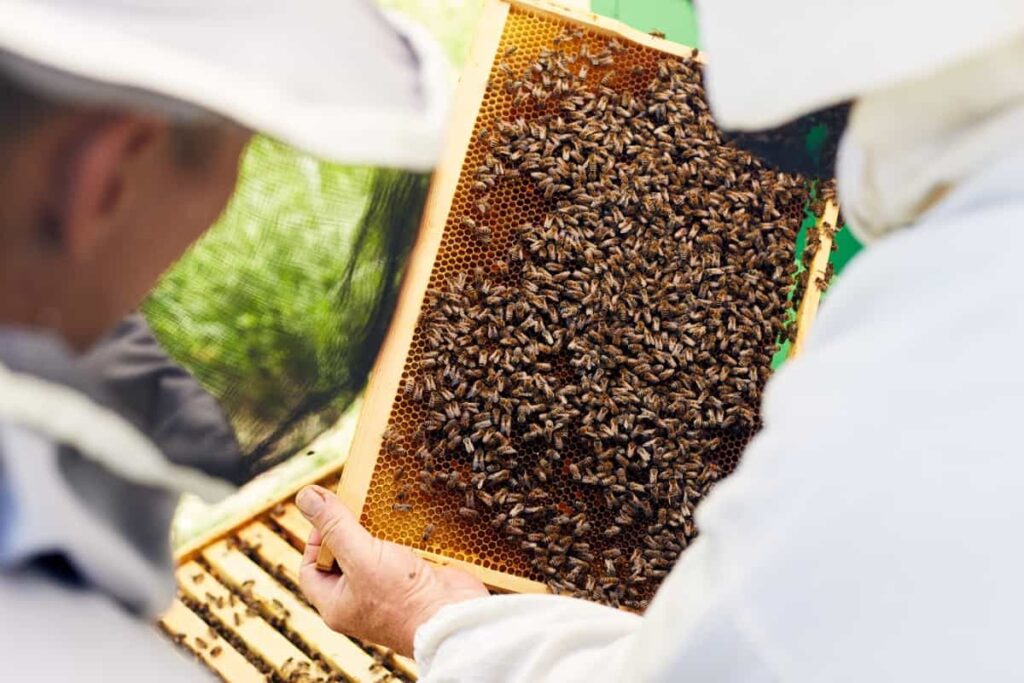
To protect yourself from stings, invest in a good-quality bee suit or jacket with a veil. Gloves are also recommended to keep your hands safe during inspections. A smoker is an important tool that helps calm bees by releasing smoke into the hive. It makes inspections easier and less disruptive for you and the bees. Other essential tools include a hive tool, a bee brush (to gently move bees without harming them), and feeding equipment (such as feeders) when natural nectar sources are scarce.
Additionally, consider investing in protective gear for your hives, such as mouse guards or entrance reducers, to prevent unwanted visitors from entering. Don’t forget about honey extraction equipment like an extractor (manual or electric) to remove honey from frames, uncapping knives or forks to remove wax seals from cells, and buckets with strainers for filtering honey before bottling it up.
Sourcing Bees and Queen Bees for Your Apiary in South Africa
One option is to purchase them from reputable breeders or suppliers. These individuals or companies specialize in breeding healthy and productive bee colonies well-suited to the local environment. Another option is to capture swarms or collect feral colonies. Capturing swarms requires knowledge, experience, and careful handling to ensure the safety of both you and the bees.
Additionally, you may consider networking with other beekeepers in your area who may have surplus colonies or queens available for sale or trade. It’s important to prioritize their health by selecting disease-resistant strains adapted to local conditions. This will help ensure strong colony growth, honey production, and overall success in your beekeeping endeavors.
Hive Management Techniques for Successful Beekeeping in South Africa
Hive management is a crucial aspect of beekeeping that requires careful attention and regular monitoring. In South Africa, where the climate can vary significantly from region to region, understanding the unique needs of your bees is essential for their success. One important technique in hive management is ensuring proper ventilation within the hives.
Bees produce heat when they are active, and without adequate airflow, this heat can build up and lead to stress on the colony. Regularly checking ventilation holes and removing obstructions will help maintain optimal bee conditions. Another key aspect of hive management is pest control. South Africa is home to various pests that can harm bee colonies, such as wax moths and varroa mites.
Regularly inspecting your hives for signs of infestation and taking appropriate measures to control these pests will help protect your bees’ health. Regularly cleaning out debris or excess propolis from frames and replacing old comb will ensure a healthy living space for your bees. Regular inspections of honey stores are vital in managing hive strength throughout different seasons.
In case you missed it: How to Start Vegetable Farming in South Africa: Commercial Business Plan, Cost, and Profit
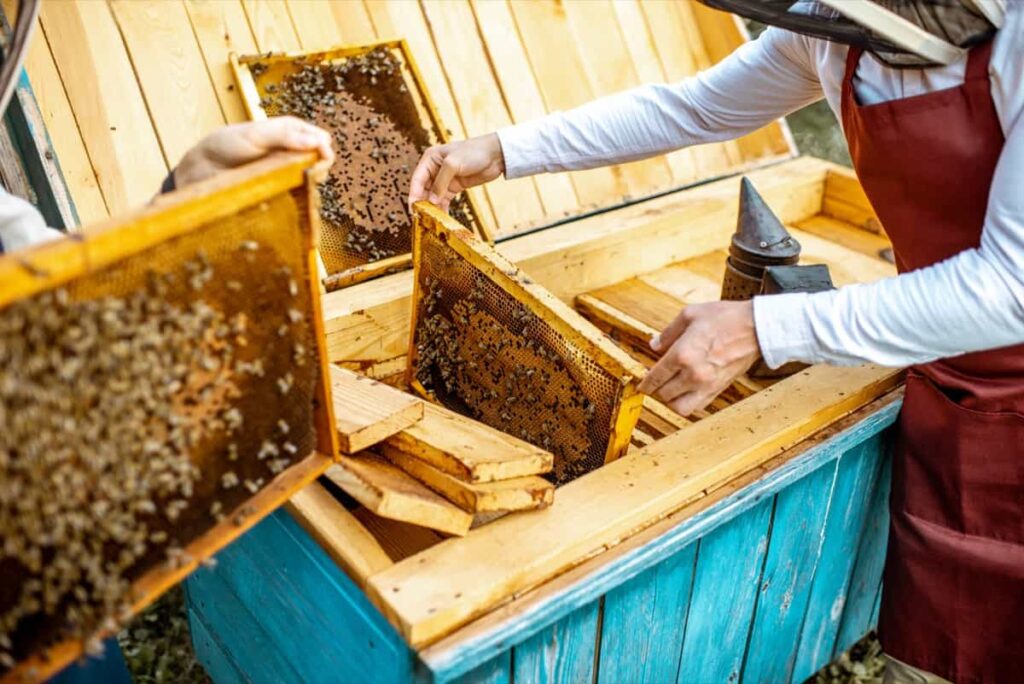
Preventing and Managing Diseases and Pests in South African Beehives
One common disease that affects honey bees in South Africa is the American foulbrood (AFB). AFB is a bacterial disease that can devastate an entire hive if left unchecked. To prevent AFB, practicing good hygiene in your beekeeping operation is important. Regularly inspect your hives for signs of infection, such as larvae with sunken cappings or a foul smell. If you suspect AFB, it’s important to report it immediately to the relevant authorities.
The Varroa mite is another pest that can wreak havoc on South African bee colonies. These tiny parasites attach themselves to bees and feed on their hemolymph, weakening them and spreading viruses. To manage Varroa mites, you can use chemical treatments approved by local regulations or opt for organic methods like powdered sugar dusting or drone brood removal.
Monitoring for other common diseases, such as European foulbrood (EFB) and chalkbrood, is also essential. EFB manifests as spotty larvae, while chalkbrood appears as white fungal growths on dead brood. Regular inspections, proper sanitation practices, and prompt action are key to preventing and managing diseases and pests in South African beehives.
Harvesting and Processing Honey in South Africa: Best Practices
In South Africa, certain best practices can help ensure a successful harvest and high-quality honey. Beekeepers should wait until the honey supers (the boxes where bees store their excess honey) are at least 70-80% capped before removing them from the hive. This ensures that most honey is fully ripened and ready for extraction. To extract the honey, beekeepers can use various methods such as centrifugal force or crush-and-strain technique.
Centrifugal extraction involves using a specialized extractor that spins the frames to remove the honey without damaging them. Crush-and-strain method requires crushing the comb with a fork or other tool and straining out impurities. Once extracted, it’s important to filter the raw honey to remove any remaining wax particles or debris. This can be done using fine mesh filters or cheesecloth.
It’s also recommended to let the filtered honey sit for a day or two for air bubbles to rise and escape. After filtering, beekeepers have different options for storing their harvested honey. Some prefer bottling it immediately, while others prefer allowing it to settle further in large containers before packaging into smaller jars. Use clean equipment and practice good hygiene when handling beeswax combs and extracted honey.
Marketing and Selling Your Honey Products in South Africa
With the increasing demand for natural and locally sourced products, there is a growing market for high-quality honey. To successfully market your honey, it’s important first to establish your target audience. One marketing strategy is to create a brand identity that resonates with consumers. Develop a unique name, design eye-catching labels, and craft a compelling story behind your honey production process.
In case you missed it: Crop Insurance Role in Driving Smart Digital Agriculture in Africa
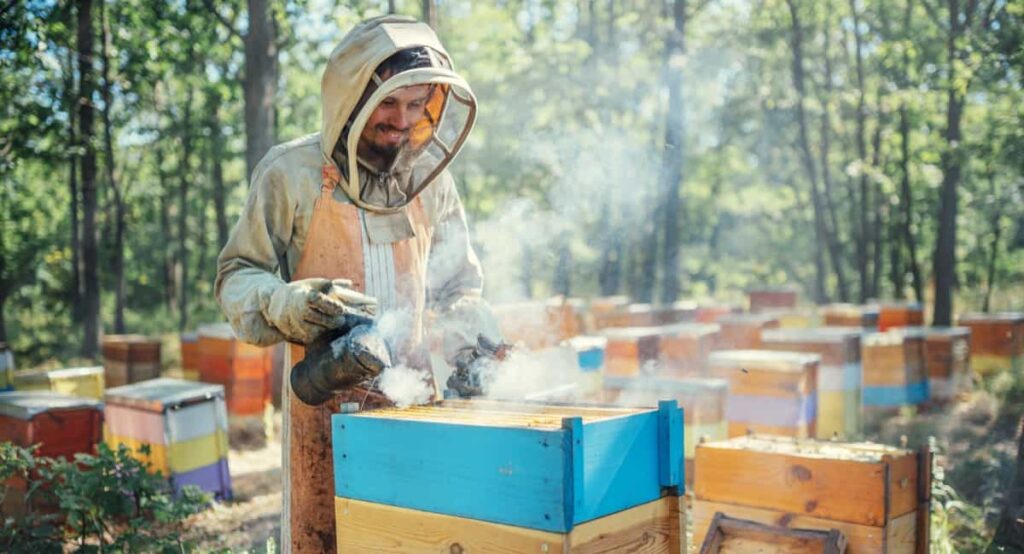
Utilize various marketing channels to promote your honey products. Establish an online platform where you can showcase mouth-watering images of golden jars filled with delicious honey. Consider creating a website where customers can easily place orders or find information about upcoming events or promotions. Participating in local farmers’ markets, food festivals, and agricultural exhibitions also provides excellent opportunities to showcase and sell your honey products directly to potential customers.
Understanding the Environmental Impact of Beekeeping in South Africa
By promoting pollination, beekeeping maintains healthy ecosystems and ensures food security. Many crops rely on bee pollination for successful fruit set and yield. It’s estimated that one-third of our global food supply depends on insect pollinators like bees. Moreover, beekeepers often maintain their hives near flowering trees or crops to provide ample nectar for their bees.
Beekeepers also advocate for sustainable land management practices as they rely on unpolluted environments with diverse floral resources. Furthermore, through education initiatives led by beekeepers and associations across South Africa, public awareness about the importance of protecting bees’ natural habitat is increasing rapidly. This helps foster a culture of conservation among communities while emphasizing the vital role played by these tiny yet mighty creatures.
Urban Beekeeping in South Africa: Is it Profitable?
The urban landscape offers a diverse range of flora, providing ample forage for bees. This means that honey production can be substantial, especially if multiple hives are strategically placed throughout the city. Additionally, urban areas often demand more locally produced honey and other bee-related products. With consumers increasingly seeking sustainable and eco-friendly options, there is potential to tap into this market and generate income. Therefore, careful hive management practices must be implemented to ensure the well-being of your bees.
Beekeeping Training in South Africa: Where to Get It?
One training source is the South African Bee Industry Organization (SABIO), which offers beginners and experienced beekeepers comprehensive beekeeping courses. Their workshops cover hive management, honey production, disease prevention, and more. These courses will provide valuable information and connect you with fellow bee enthusiasts who can offer guidance and support.
In case you missed it: South Africa Vegetable Planting Calendar: Month Wise, Schedule, Chart, and Guide
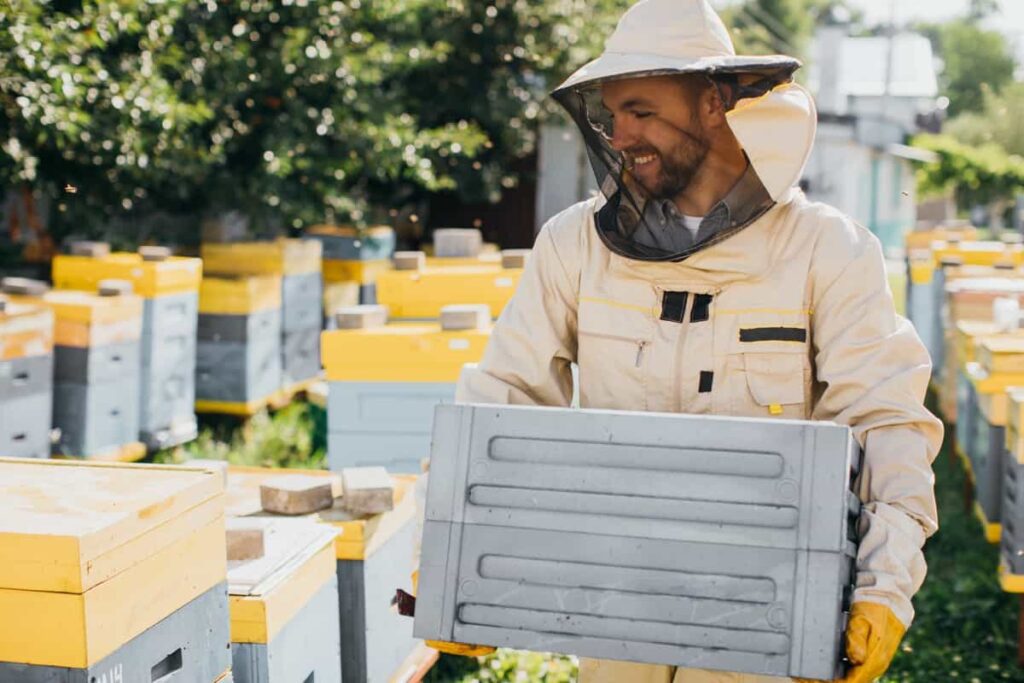
Another option is to contact local beekeeping associations and networks in your area. These organizations often organize workshops, seminars, and field days where you can learn from experienced beekeepers. They may also have mentorship programs that allow newcomers to shadow seasoned professionals and gain hands-on experience. Additionally, consider seeking online resources such as webinars or video tutorials from reputable international organizations.
Beekeeping in South Africa: Requirements, License, Cost and Training
| Requirement/Detail | Description | Cost (in ZAR) |
| Initial Setup | ||
| Land Acquisition | Suitable area for apiary, considering floral sources, water access, and distance from public spaces. | Varies |
| Beehives (Standard Langstroth) | Purchase of initial hives including frames and foundations. | 1,500 per hive |
| Protective Gear | Includes bee suit, gloves, veil, and boots. | 2,500 |
| Beekeeping Toolkit | Bee smoker, hive tool, bee brush, and frame grip. | 1,200 |
| Initial Bee Colonies | Purchase or adoption of bee swarms or packaged bees. | 1,800 per colony |
| Training and Certification | ||
| Basic Beekeeping Training | Introductory course covering bee biology, behavior, and hive management. Offered by the fictitious SA Beekeeping Institute. | 4,500 |
| Advanced Beekeeping Training | Delving deeper into bee diseases, queen rearing, and advanced management techniques. | 7,000 |
| Specialized Workshops | Topics like Honey Production, Medicinal Uses of Hive Products, and Sustainable Beekeeping Practices. | 3,000 – 5,500 |
| Licensing and Regulatory Requirements | ||
| Initial Licensing | Application for a beekeeping license, which may involve an inspection of your apiary site by officials. | 3,000 |
| Annual License Renewal | Yearly renewal fees. Some regions might require evidence of continued education or attendance at workshops. | 1,500 |
| Bee Health and Disease Management Course | Some regulations may require beekeepers to have training in managing bee diseases and pests, to ensure the health of local bee populations. | 3,500 |
| Ongoing Expenses | ||
| Hive Maintenance | Replacement of frames, hive bodies, and other materials that wear out or get damaged. | 1,000 annually |
| Disease Management | Costs associated with treatments for mites, fungi, or other bee health concerns. | 1,500 annually |
| Honey Extraction Equipment | Initial purchase of centrifugal extractors, filters, and storage containers. | 12,000 |
Conclusion
Beekeeping provides opportunities for rural economic development as small-scale farmers can generate income from selling honey products such as raw honey or value-added products. By pollinating crops and wildflowers, bees contribute to the growth of fruits, vegetables, nuts, and seeds. This enhances agricultural productivity and supports local farmers by increasing crop yields. This boosts the economy through job creation and increased revenue from agricultural exports.
- Crops Grown in Summer Season: Best Choices for Summer Gardening
- Organic Pest Control for Tomato Farming
- How to Maximize Sheep Farming Profit
- Broccoli Varieties: Choosing the Right Cultivars for Your Farm
- How to Raise Pigs in Your Own Backyard: A Comprehensive Guide
- Budget Friendly Sheep Shed Ideas: Cheap and Low-Cost Tips
- How Much Do Cattle Farmers Make: Revenue Streams in Cattle Farming
- Management Pests and Diseases in Your Cotton Field
- Sheep Farming Business Plan for Beginners
- Aquaponic Farming at Home: A Step-By-Step Guide
- Profitable Village Farming Business Ideas in 2024
- High-Yield Aquaculture: Fast-Growing Fish for Farming
- Effective Fish Pond Construction Techniques for Beginners
- Irrigation and Water Management in Pineapple Farming
- Blossom to Harvest: Mastering Flowering and Pollination in Papaya Farming
- Pig Fattening Essentials: From Selection to Sale for Beginners
- Raising Wagyu Cattle: A Complete Guide for Premium Beef Production
- Soil Types and Their Water Holding Capacity
- Optimizing Irrigation Schedules for Coconut Groves for Enhanced Yield
- Espresso Your Garden: Coffee Grounds for Healthier Acid-Loving Plants
- The Best Soil Mix for Snake Plants: How to Mix Your Own Snake Plant Soil
- Green Thumb Success: Expert Tips for Cultivating Greenhouse Beans All Year Round
- Bloom All Year Round: The Ultimate Guide to Indoor Hyacinth Care
- Eco-Friendly Gardening: How to Make Liquid Fertilizer from Kitchen Waste
- Ultimate Guide to Grow Anise in Pots: Explore Seed Propagation to Harvesting
- Guide to Raising Chester White Pigs: Discover Breed Facts to Growth Management
- Mastering the Elegance: The Ultimate Guide to Weeping Cherry Tree Care, Planting, and Maintenance
- Ultimate Guide to Planting Garlic in Grow Bags: Growing Strategies for Beginners
- How to Fix Spider Plant Leaf-Related Problems: Natural and Organic Remedies
- 10 Reasons Why Your Tulsi Plant is Shedding Leaves: Home Remedies and Solutions
- Optimizing Growth and Yield: The Advantages of Palm Bunch Ash Fertilizer
- Utilizing Neem Oil Extract as a Natural Pesticide for Hydrangea
- From Soil to Harvest: Various Ways in Which Farmers Can Use AI Tools
- Steps to Encourage and Induce Citrus Flowers: A Comprehensive Guide
- How to Fix Snake Plant Leaf-Related Issues: Natural and Organic Remedies
- Transform Your Garden into a Fragrant Oasis with Raat Ki Rani (Night Blooming Jasmine)
